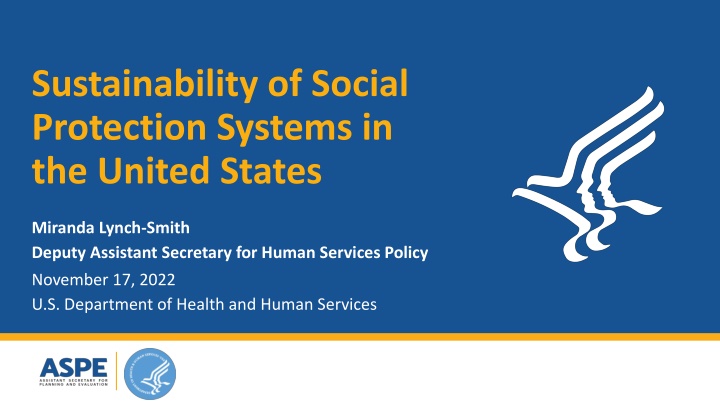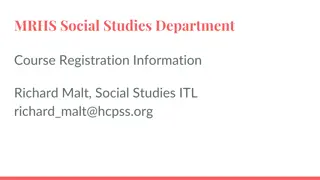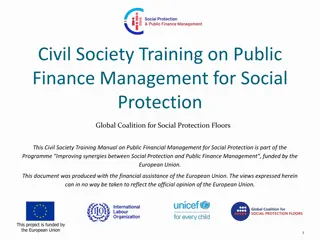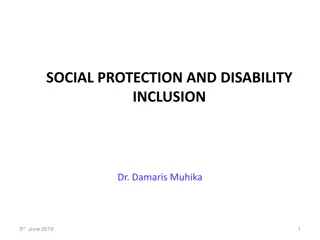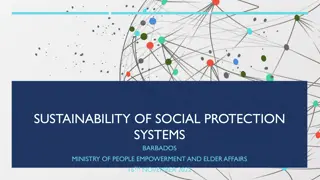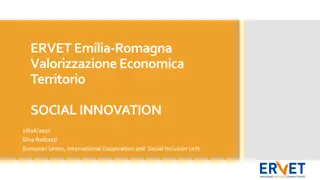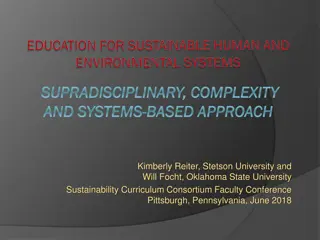Sustainable Social Protection Systems in the United States: A Comprehensive Overview
This presentation highlights the sustainability of social protection systems in the United States, focusing on prevention services, Medicaid's addressing of health-related social needs, and the federated social safety net operated by various national departments and local governments. It emphasizes the importance of well-targeted safety net services in preventing adverse outcomes and improving health and social well-being through interventions ranging from primordial to tertiary prevention.
Download Presentation

Please find below an Image/Link to download the presentation.
The content on the website is provided AS IS for your information and personal use only. It may not be sold, licensed, or shared on other websites without obtaining consent from the author.If you encounter any issues during the download, it is possible that the publisher has removed the file from their server.
You are allowed to download the files provided on this website for personal or commercial use, subject to the condition that they are used lawfully. All files are the property of their respective owners.
The content on the website is provided AS IS for your information and personal use only. It may not be sold, licensed, or shared on other websites without obtaining consent from the author.
E N D
Presentation Transcript
Sustainability of Social Protection Systems in the United States Miranda Lynch-Smith Deputy Assistant Secretary for Human Services Policy November 17, 2022 U.S. Department of Health and Human Services
Overview Prevention Services: Approaches to preventing adverse outcomes Medicaid and Health-Related Social Needs Foster Care Prevention Services Nutrition assistance: benefits that respond to changing economic need 2
U.S. Operates a Federated Social Safety Net from Different National Departments Federal Government Territories (Guam, Puerto Rico, etc.) 50 States + District of Columbia Tribal Governments (574) Local governments 3
Prevention Services: Preventing Adverse Outcomes Well-targeted safety net services can prevent a range of adverse outcomes, such separating families, poor birth outcomes and child development, and criminal justice system involvement. New strategies across the U.S. government target prevention services in a range of areas. Prevention services focus on different stages of intervention: primordial, primary, secondary, and tertiary. Interventions for those already affected Tertiary prevention Targeted at those in need to alleviate problems and prevent escalation Secondary prevention Primary prevention Targeted at high-risk populations or environments before problems emerge Targeted at social and structural policies affecting health & well-being Primordial prevention 4
Medicaid Addresses Health-Related Social Needs Medicaid is a national health insurance program for low-income people, funded jointly by the federal and state governments. Covers over 1 in 5 people in U.S. Historically a permanent funding source for health-related needs In 2021 the Medicaid program clarified that funding can address participants health-related social needs, such as food and housing insecurity. Services provided based on individual needs, rather than one size fits all States can use Medicaid health care funds to cover services such as: Housing services and supports Non-medical transportation Community integration Social supports Home-delivered meals Educational services Employment services Case management 5
Prevention through Medicaid: Expected Impact Housing. Housing interventions (such as vouchers) to improve health outcomes, including chronic health conditions, behavioral health conditions, hospitalizations, emergency department visits, and may reduce certain costs to health systems. Nutrition and food access. Food and nutrition programs can reduce obesity and increase physical activity among children and adults, and are associated with reduced health care costs and improved health outcomes. Transportation. Providing transportation can increase preventive and outpatient care and decrease expensive emergency care. Economic support. Cash transfers and other income support are related to improved self-reported health outcomes, improved maternal health and birth outcomes (e.g. higher birth weight). See: Addressing Social Determinants of Health: Examples of Successful Evidence- Based Strategies and Current Federal Efforts 6
Preventing Adverse Outcomes: Foster Care The U.S. foster care system provides substitute care for some children who are separated from their families, largely due to maltreatment. Foster care predicts many adverse outcomes for children in areas like child development, academic achievement, and substance use. Since 2018, a new law allows federal spending on certain mental health, substance use, and parenting skills services to prevent children from entering foster care. To get funding, states need plans to implement evidence-based programs, improve research on programs with limited evidence of effectiveness, and track the outcomes of children and families. 7 See: The Administration for Children and Families Foster Care Prevention Program
Foster Care Prevention: Expected Impact States have only recently begun implementing newly-funded prevention services. Evidence still emerging. Prevention programs focus on parenting skills and parental substance misuse. Funded interventions have rigorous evidence of effectiveness, and are expected to: Reduce the number of children living away from their parents. Shorten time children live out of the home. Improve the safe and positive parenting practices, and the safety and well-being of children. 8 See: The Administration for Children and Families Foster Care Prevention Program
Nutrition Assistance SNAP (Supplemental Nutrition Assistance Program): provides nutrition benefits to low-income families. Funding is not capped: all eligible families can receive SNAP. During the COVID economic downturn, the U.S. expanded SNAP benefits: simplifying eligibility requirements instituting emergency supplementary benefits increased maximum benefit amounts revised nutrition formulas to cover costs of healthy food. Average household monthly benefits rose from a pre- pandemic average of $258 to over $400. SNAP Enrollment (in millions) 45.8 41.2 35.7 Average Monthly Benefit ($USD) $442 $258 $258 2015 2016 2017 2018 2019 2020 2021 2022 9 See: The Supplemental Nutrition Assistance Program
Nutrition Assistance: Impact Prior to the pandemic, SNAP benefits kept 6 million people out of poverty a year. SNAP benefits filled in some of the gap when pandemic-related economic stimulus ended in 2022. Anti-poverty effect in 2022 grew, keeping 11.6 million out of poverty People Kept out of Poverty by SNAP 11.6 million 6.0 million 2018 2022 10 See: Poverty in the US: 2021
U.S. Lessons Learned Prevention services: Permanent funding streams are critical to develop the infrastructure for effective programs. Measuring program effectiveness of prevention is essential resource intensive Nutrition Assistance: Model for being responsive to changing economic conditions Administrative flexibility enabled program to grow and adapt to scale of need Relative minor administrative changes can make a substantial difference in household economic well-being 11
Thank you! Miranda.LynchSmith@hhs.gov Robin.Ghertner@hhs.gov 12
